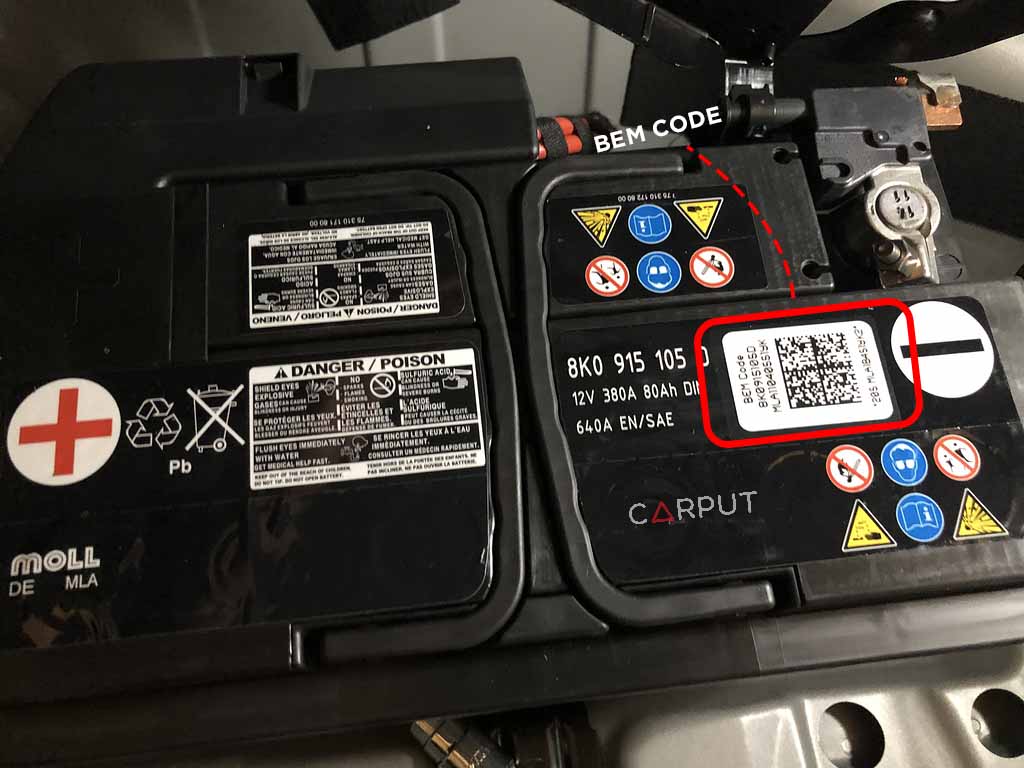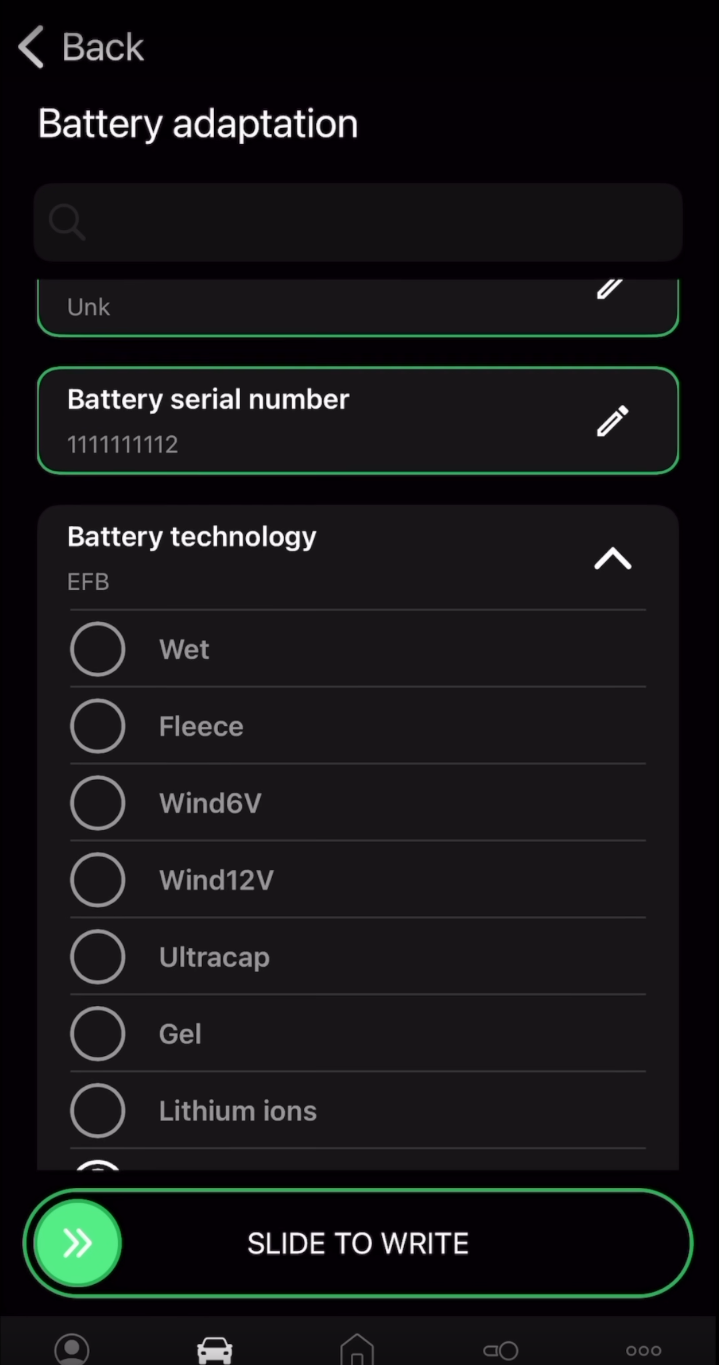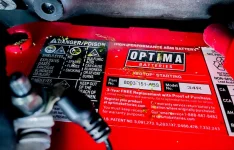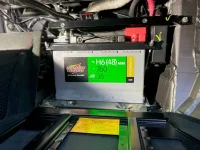I've had AGM batteries with the correct charger last over 10 years.Just replaced my agm bought in 6/2015 , it didn't get that memo. Still cranked fine but cca was getting low according to the tester.
2012 Toyota Sienna oem battery was wet cell.
You are using an out of date browser. It may not display this or other websites correctly.
You should upgrade or use an alternative browser.
You should upgrade or use an alternative browser.
Any reason to not switch to AGM?
- Thread starter cutlassvillager
- Start date
gathermewool
Site Donor 2023
Different charging voltages, charging routines and state-of-charge calibration. Manufacturers use different batteries depending on region, climate and...market I assume.

That is with respect to the same battery type. Updating the “battery energy controller” from its aged-battery-scheme to a new-battery won’t change the default battery type, eg, flooded cell vs AGM. In fact, based on the video, updating to a new battery will less “aggressively“ charge a new battery.
That video is a reference to basic registering on a modern vehicle.That is with respect to the same battery type. Updating the “battery energy controller” from its aged-battery-scheme to a new-battery won’t change the default battery type, eg, flooded cell vs AGM. In fact, based on the video, updating to a new battery will less “aggressively“ charge a new battery.
If a modern vehicle supports AGM type coding it shows up as an option.
gathermewool
Site Donor 2023
That video is a reference to basic registering on a modern vehicle.
If a modern vehicle supports AGM type coding it shows up as an option.



1. Most people just want to swap a battery
2. How common is it for most OEMs to offer this option to switch between flooded and AGM?
You can still put an AGM in a FLA car. It will work, but it will have a shorter lifespan. Then they usually make a review or comment on the internet saying AGM is inferior to FLA.1. Most people just want to swap a battery
2. How common is it for most OEMs to offer this option to switch between flooded and AGM?
2. I don't know, but most euros I've worked on for about 5 years have been able to. Some Range Rovers will automatically adapt. I'm sure other manufacturers' implement an auto adapt scheme. Newer Hondas are OEM EFB which can accept an AGM no issue. Many Fords are OEM AGM.
But the statement that AGM battery manufacturers have thoughtfully designed AGM batteries to be dropped into FLA vehicles is simply not correct.
f355spider
$50 Site Donor 2025
AGM is fine in most cars that came with flooded. I haven't had an issue. Consumer Reports in their testing, show the AGMs to appear as a group to perform near the top in performance and life. Yes, there are still flooded models that can perform well, but CR says consumers should consider an AGM as they can be worth the added expense.
I have an AC Delco AGM Group 49 H8 in my 22 yo BMW for almost 4 years, no issues at all. I load tested it recently and it still exceeds the CCA rating on the label. The car came with a Douglas brand flooded battery from new.
I have an AC Delco AGM Group 49 H8 in my 22 yo BMW for almost 4 years, no issues at all. I load tested it recently and it still exceeds the CCA rating on the label. The car came with a Douglas brand flooded battery from new.
Last edited:
f355spider
$50 Site Donor 2025
You may be surpised with your replacement Red Top. In the past 8 years, I have been through three Optima Red Tops in my Ferrari. They performed great with high CCA, but all three leaked within two to three years out those two black vent caps in the top. I only kept buying them because the battery tray was custom fitted for the Red Top as it was OEM for my car. I got a regular battery tray and fitted an Interstate AGM earlier this year. I have purchased Optima Red Top in the past and they were great, but seems something changed with their quality.The Optima Redtop in my daily driver lasted 9 yrs so I replaced it with another.
I posted about my problems with Red Tops on a Ferrari forum and two Ferrari technicians chimed in with similar issues with Red Tops and posted photos of similar leaks and said they no longer use them.
Attachments
Last edited:
Johnson Controls sold the battery division a few years back. They made optima. I worked for them an you could get one shipped to your door for like $55. It was cool they shared perks with all employeesYou may be surpised with your replacement Red Top. In the past 8 years, I have been through three Optima Red Tops in my Ferrari. They performed great with high CCA, but all three leaked within two to three years out those two black vent caps in the top. I only kept buying them because the battery tray was custom fitted for the Red Top as it was OEM for my car. I got a regular battery tray and fitted an Interstate AGM earlier this year. I have purchased Optima Red Top in the past and they were great, but seems something changed with their quality.
I posted about my problems with Red Tops on a Ferrari forum and two Ferrari technicians chimed in with similar issues with Red Tops and posted photos of similar leaks and said they no longer use them.
Older Merc (06) and just dropped in a Walmart AGM - from memory (?) first replacement main battery after OEM, (they have two batteries). No registration or coding available. Battery life was fine until I sold it last year. Later model (2016) BMW requires new AGM (H8) battery registration when replacing, so the charging algorithm adjusts to a lower rate for the new battery, and then builds over time. Smart charging system adjusts charging rate based on battery age and Ah. Importantly coding (not registration) lets the controller know the capacity (Ah) of the battery.
Installed OEM battery is 92Ah, but most available H8/49 replacements are 95Ah. Not sure if the +3 Ah matters but requiring a new battery will be my catalyst to buy an OBD bi-directional scanner, needed even if one just registers. Most below $500 scanners only register, do NOT code so not certain what to do without further research. Have also noticed on YouTube vids, that many OBD scanners may NOT provide a 92 AH setting, only 90 Ah or 95 Ah. Recommendation is to go to the next lowest setting - in my case 90 Ah, 2 Ahs below.
so not certain what to do without further research. Have also noticed on YouTube vids, that many OBD scanners may NOT provide a 92 AH setting, only 90 Ah or 95 Ah. Recommendation is to go to the next lowest setting - in my case 90 Ah, 2 Ahs below.
If I get the same (92 Ah) in the replacement, registration will be relatively easy with a more affordable bi-directional scanner with no need to code.
Oh the joys of owning a newer "hi-tech" car!!
Installed OEM battery is 92Ah, but most available H8/49 replacements are 95Ah. Not sure if the +3 Ah matters but requiring a new battery will be my catalyst to buy an OBD bi-directional scanner, needed even if one just registers. Most below $500 scanners only register, do NOT code
If I get the same (92 Ah) in the replacement, registration will be relatively easy with a more affordable bi-directional scanner with no need to code.
Oh the joys of owning a newer "hi-tech" car!!
they got bought out as per regular merican policy, and moved manufacturing S of the border. Ie:You may be surpised with your replacement Red Top. In the past 8 years, I have been through three Optima Red Tops in my Ferrari. They performed great with high CCA, but all three leaked within two to three years out those two black vent caps in the top. I only kept buying them because the battery tray was custom fitted for the Red Top as it was OEM for my car. I got a regular battery tray and fitted an Interstate AGM earlier this year. I have purchased Optima Red Top in the past and they were great, but seems something changed with their quality.
I posted about my problems with Red Tops on a Ferrari forum and two Ferrari technicians chimed in with similar issues with Red Tops and posted photos of similar leaks and said they no longer use them.
when a brand excels it wins some mrkt share, becomes 'known'. Sells on that 'name' but cuts
costs & 'rides' on that name as long as possible. I began to see the biz model in the '60s w/Fry boot.
East Penn recommends a charging voltage of 13.8V-14.8V (at 77F) for their AGM batteries. Since alternator charging of batteries is usually limited by the commute time, charging at the highest allowed voltage of 14.8V would be preferred, to reduce undercharging.
https://www.eastpennmanufacturing.com/wp-content/uploads/Battery-Care-Maintenance-0004.pdf
https://www.eastpennmanufacturing.com/wp-content/uploads/Battery-Care-Maintenance-0004.pdf
If you got 6 years out of that tiny battery consider yourself VERY lucky. Hondas with small batteries are know to fail every 2-3 years almost like clockwork. If you’re not the original owner of the car then I’d suspect it was changed once before.
subscribed
as I have 1 vehicle w/3G alt & agm (+ on bd NOCO, so small concern) BUT
post #33 is a point of interest for me.
(is off rd, winch, other hi draw equipment)
as I have 1 vehicle w/3G alt & agm (+ on bd NOCO, so small concern) BUT
post #33 is a point of interest for me.
(is off rd, winch, other hi draw equipment)
See what kind of pro rate the Honda dealer will give you on a new dealer battery.Well my 2016 Accord needed a jump this morning. I'm pretty sure it is the factory battery, so I know I was already on borrowed time.
I am planning to replace it with an AGM 51R - thinking either the DieHard Platinum (Part # 51R-AGM) or a Super Start Platinum (Part # 51RPLT). My options seem somewhat limited presumably due to the size and the reverse terminal position. I'm leaning towards the Super Start due to more reviews and slightly higher CCA.
The reasons why I'm considering an AGM are:
- Longevity - planning to keep the vehicle for a long time still, although to be fair the Honda battery has lasted a very long time.
- The car sits for longer stretches at times / also is sometimes short tripped (~10 minute drives)
- 51R is kind of a small battery - Honda put these smaller batteries in the 4-cylinder models. I'm aware you can buy the parts for a V6 Accord to "upgrade" to the larger battery. I'd rather go this route if it makes sense / AGM would help.
- Personal experience - I've been impressed with how long I've seen AGM batteries last in other family / friends' vehicles.
- Location - I live in Michigan where we have decent temperature swings
- Podcast Recommendation - One of my favorite automotive podcasts, Under the Hood Show, often recommend that people switch to AGM. They do so without referencing any particular brand.
Other than cost, is there any reason I shouldn't get an AGM battery? I know there are small differences in charging rates / expected voltage when comparing Flooded vs. AGM, but surely battery manufacturers have taken this into account?
gathermewool
Site Donor 2023
East Penn recommends a charging voltage of 13.8V-14.8V (at 77F) for their AGM batteries. Since alternator charging of batteries is usually limited by the commute time, charging at the highest allowed voltage of 14.8V would be preferred, to reduce undercharging.
https://www.eastpennmanufacturing.com/wp-content/uploads/Battery-Care-Maintenance-0004.pdf
That’s my take, as well.
To clarify one point, 13.8VDC is likely the ideal float voltage and 14.8VDC is what’s required to fully charge the battery.
Flooded lead acid batteries have a similar float voltage, but 14.8VDC is closer to equalizing voltage when fully charged, which will likely result in gassing the battery and eroding the plates over time.
gathermewool
Site Donor 2023
What is the AH rating used for, the charge rate as a fraction of C? If so, I would think that 2AH is insignificant. I wonder what the actual difference in voltage is when the battery is fully charged.Older Merc (06) and just dropped in a Walmart AGM - from memory (?) first replacement main battery after OEM, (they have two batteries). No registration or coding available. Battery life was fine until I sold it last year. Later model (2016) BMW requires new AGM (H8) battery registration when replacing, so the charging algorithm adjusts to a lower rate for the new battery, and then builds over time. Smart charging system adjusts charging rate based on battery age and Ah. Importantly coding (not registration) lets the controller know the capacity (Ah) of the battery.
Installed OEM battery is 92Ah, but most available H8/49 replacements are 95Ah. Not sure if the +3 Ah matters but requiring a new battery will be my catalyst to buy an OBD bi-directional scanner, needed even if one just registers. Most below $500 scanners only register, do NOT codeso not certain what to do without further research. Have also noticed on YouTube vids, that many OBD scanners may NOT provide a 92 AH setting, only 90 Ah or 95 Ah. Recommendation is to go to the next lowest setting - in my case 90 Ah, 2 Ahs below.
If I get the same (92 Ah) in the replacement, registration will be relatively easy with a more affordable bi-directional scanner with no need to code.
Oh the joys of owning a newer "hi-tech" car!!
My Legacy had a TSB four or so years ago to update the charging logic due to complaints of inadequate charging and dead batteries. Unfortunately I didn‘t monitor voltage then, but I do now.
Currently, the voltage is almost always between 14.1 and 14.3VDC, maybe dropping to 13.9 or 14.0 on long highway trips. What’s odd is that after I charge the battery at home using either the CTEK or NOCO smart charger, the voltage will drop into the 12s, even as low as 12.0VDC for a short period of time if I drive off right away.
My old 08 Civic would habitually undercharge the battery. No matter the SoC it would drop into the 12s while idling, for instance. This might have been OK, but it resulted in a noticeable vibration. I had to trick it into raising the voltage to normal by turning the parking lights on. I didn’t have the ability to charge the battery often like I do now, so it was pretty annoying.
Exide recommends a maximum charging voltage (at 77F) of 14.4V for both flooded and AGM batteries.
https://s3-eu-west-1.amazonaws.com/exide/Exide+(Flooded)+User+Manual.pdf
https://s3-eu-west-1.amazonaws.com/exide/Exide+(VRLA)+User+Manual.pdf
For AGM:
https://s3-eu-west-1.amazonaws.com/exide/Exide+(Flooded)+User+Manual.pdf
https://s3-eu-west-1.amazonaws.com/exide/Exide+(VRLA)+User+Manual.pdf
For AGM:
D1. Charging: Initially charge at 10–20A of constant current until reaching 14.4V, followed by a regulated Voltage charge at 14.4V without current limitation until supplied current is below 2% nominal Capacity; nish at constant current of 2% nominal Capacity during 2h. During all charging, battery temperature can’t exceed 50°C.
D2. Float Charging only for Stationary: Apply a oating voltage of 13.8V during the whole charging time and consider applying D1 once per month. Never apply this method to deeply- discharged batteries.
D3. Fast Charging only for Emergencies: Use a max. current of 50% nominal Capacity for periods shorter than 1 hour. In all cases voltage must be limited to 15V maximum. Never apply this method to deeply-discharged batteries.
D4. Recovering from deep discharge. When battery voltage is below 12.1V, proceed as described in D1 but prolong total duration for step one and two up to 48h. During all charging, battery temperature can’t exceed 50°C.
Trojan recommends a maximum charging voltage (at 77F) of 14.7V for a flooded battery and 14.4V for an AGM battery.
The often repeated advice that AGM batteries require higher charge voltage than a flooded battery is not always true, as shown by the data from Exide and Trojan.
https://www.trojanbattery.com/tech-support/battery-maintenance/
https://www.trojanbattery.com/pdf/TrojanBattery_UsersGuide.pdf
The often repeated advice that AGM batteries require higher charge voltage than a flooded battery is not always true, as shown by the data from Exide and Trojan.
https://www.trojanbattery.com/tech-support/battery-maintenance/
https://www.trojanbattery.com/pdf/TrojanBattery_UsersGuide.pdf
Last edited:
I don’t disagree with you. But… Fords active battery management system. I’ve mentioned it in detail on this forum. Have a dash mounted DVM and have messed with the battery management settings and watched how it shifts the strategy around. ford targets an 80% SOC by default, which also means it does not aim for a 100% SOC.There is no way that your vehicle runs for any period of time at 12.4-12.6VDC. 12.6VDC isn’t full-charge voltage. The only time I see this is when driving after the battery has been on a charger and fully charged. Otherwise, the voltage should be 14+ VDC or at least in the 13s for a proper float voltage.
Similar threads
- Replies
- 19
- Views
- 1K
- Replies
- 15
- Views
- 7K
- Replies
- 29
- Views
- 3K
- Replies
- 83
- Views
- 4K


